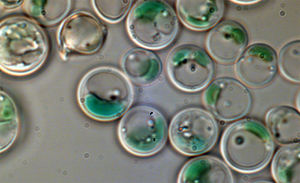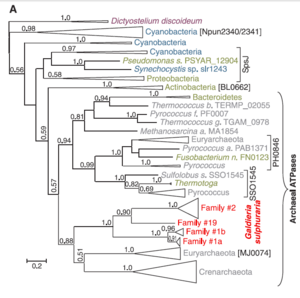Galdieria sulphuraria: Difference between revisions
| Line 16: | Line 16: | ||
==Genome Structure== | ==Genome Structure== | ||
Phylogenetic and genomic analyses supplied by, Gerald Schönknecht et al. revealed 75 indications of horizontal gene transfer from archaea and bacteria along with highly condensed protein coding regions within the ''G. sulphuraria'' genome [6]. It is speculated that minimally 5% of the functional genes were acquired in this way [1]. | ''G. sulphuraria'' has a 13.7 Mbp genome, with a G+C concentration of 37%. Phylogenetic and genomic analyses supplied by, Gerald Schönknecht et al. revealed 75 indications of horizontal gene transfer from archaea and bacteria along with highly condensed protein coding regions within the ''G. sulphuraria'' genome [6]. It is speculated that minimally 5% of the functional genes were acquired in this way [1]. | ||
Success of ''G. sulphuraria'' in a diverse array of extreme habitats appears to be facilitated by the acquisition and subsequent duplication of variety of genes not limited to heat tolerant archael ATPases, bacterial halophilic sodium-proton antiporters and thermoacidophilic arsenical membrane protein pumps along with the metal reducing mercuric reductase native to proteobacteria [6]. | Success of ''G. sulphuraria'' in a diverse array of extreme habitats appears to be facilitated by the acquisition and subsequent duplication of variety of genes not limited to heat tolerant archael ATPases, bacterial halophilic sodium-proton antiporters and thermoacidophilic arsenical membrane protein pumps along with the metal reducing mercuric reductase native to proteobacteria [6]. | ||
Revision as of 23:12, 20 April 2013

Classification
Domain: Eukaryota; Class: Rhodophyta; Family: Cyanidiaceae; Genus: Galdieria
Species
Species: Galdiera sulphuraria
Description and Significance
Galdieria sulphuraria is a eukaryotic, spore-forming, coccus. G. sulphuraria appears yellow-green to dark blue-green grown heterotrophically in liquid culture, and often yellow or green in its natural environment[1]. It is an acidophile, as well a thermophile, and inhabits highly acidic springs at high temperatures[4].
G. sulphuraria is a mixotrophic organism capable of both photosynthesis and the catabolism of a wide variety of metabolites[3].
first discovered when and by whom?
Genome Structure
G. sulphuraria has a 13.7 Mbp genome, with a G+C concentration of 37%. Phylogenetic and genomic analyses supplied by, Gerald Schönknecht et al. revealed 75 indications of horizontal gene transfer from archaea and bacteria along with highly condensed protein coding regions within the G. sulphuraria genome [6]. It is speculated that minimally 5% of the functional genes were acquired in this way [1].
Success of G. sulphuraria in a diverse array of extreme habitats appears to be facilitated by the acquisition and subsequent duplication of variety of genes not limited to heat tolerant archael ATPases, bacterial halophilic sodium-proton antiporters and thermoacidophilic arsenical membrane protein pumps along with the metal reducing mercuric reductase native to proteobacteria [6].
In addition to extremophilic adaptations, fungal metabolite transporters contribute to G. sulphuria's ability to utilize a medley of unusual carbon sources and distinguish it genetically even from "closely" related species [6].
Cell Structure, Metabolism and Life Cycle
G. sulphuraria is a mixotrophic eukaryote presenting a multilobed chloroplast and net-like mitochondrion and is roughly round in shape[2].
G. sulphuraria is capable of metabolic flexability, with the ability to grow photoautotrophically, photoheterotrophically, or chemoheterotrophically on greater than 50 carbon sources [3]. Experiments in growing G. sulphuraria in laboratory conditions conditions determined that G. sulphuraria growth is optimal at about 150 g/liter of glucose or fructose, growth is inhibited above 200 g/liter, and does not occur above 400 g/liter [8].
G. sulphuraria reproduces via the formation of 4-32 spores[2].
Ecology

G. sulphuraria is found in extreme habitats such as the hot sulfur springs of Italy, Russia, Yellowstone park, and Iceland in pH values between 0 and 4 and in temperatures up to 56 degrees Celsius [4]. It can also tolerate high metal concentrations [3].
G. sulphuraria can make up up to 90% of the total microbial mass in some environments [1], however it often exists alongside Cyanidioschyzon merolae and Cyanidium caldarium [7].
possible symbiotic relationships?
Applications to Biotechnology
"The PC production rates were 11-21 times higher than previously reported for heterotrophic G. sulphuraria 074G grown on glucose and 20-287 times higher than found in phototrophic cultures of Spirulina platensis, the organism presently used for commercial production of PC."[5]
" the alga tolerates high concentrations of toxic metal ions such as cadmium, mercury, aluminum, and nickel, suggesting potential application in bioremediation." [9]
References
[1] http://link.springer.com/content/pdf/10.1007%2Fs00253-007-1150-2.pdf
[2] http://link.springer.com/content/pdf/10.1023%2FA%3A1004035224715.pdf#page-1
[3] http://www.ncbi.nlm.nih.gov/pubmed/23471408
[4] http://genomics.msu.edu/galdieria/about.html
[5] http://www.ncbi.nlm.nih.gov/pubmed/17786429
[8] http://onlinelibrary.wiley.com.proxy1.cl.msu.edu/doi/10.1002/bit.20417/pdf
[9] http://www.ncbi.nlm.nih.gov/pubmed/15604662

